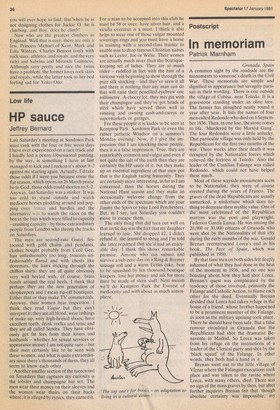Postscript
In memoriam
Patrick Marnham
Granada, Spain A common sight by the roadside are the monuments to someone's death in the Civil War. These memorials are simple and dignified in appearance but savagely partisan in their wording. There is one outside the village of Cobisa, near Toledo. It is a gravestone standing under an olive tree. The farmer has ploughed neatly round it year after year. It lists the names of four men called Redondo who died on 6 September 1936. Then, in one line, the stone comes to life. 'Murdered by the Marxist Gang'. The four Redondos were a little unlucky. That particular village was only held by the Republicans for the first two months of the war. Three weeks after their death it was occupied by the Nationalist forces which relieved the fortress at Toledo. Also the leader of the Castilian Falange was called Redondo, which could not have helped them much.
Most of these wayside monuments seem to be Nationalist, they were of course erected during the years of Franco. The graves of the dead Republicans are usually unmarked, a misfortune which does nothing to decrease their mythic value. One of the most celebrated of the Republican martyrs was the poet and playwright, Federico Garcia Lorca. He was among the 20,000 or 30,000 citizens of Granada who were shot by the Nationalists of that city during the early months of the war. Gerald Brenan reconstructed Lorca's end in his book, The Face of Spain, which was published in 1950.
By that time men on both sides felt deeply ashamed of what they had done in the heat of the moment in 1936, and no one was boasting about how they had shot Lorca. Brenan's quest was complicated by the tendency of those involved, primarily the Falange and Catholic Action, to blame each other for the deed. Eventually Brenan decided that Lorca had taken refuge in the house of a friend, whose brother happened to be ft prominent member of the Falange. as soon as the military uprising took place. There he should have been safe. But a false rumour circulated in Granada that the Republicans had shot the dramatist Benavente in Madrid. So Lorca was taken from his refuge on the instructions of a leader of the Clerical party and shot by the 'black squad' of the Falange. In other words, they both had a hand in it.
Brenan went out to the little village of Viznar where the Falangist executions took place and was taken to the ravine where Lorca, with many others, died. There was no sign of the mass graves by then, but after further inquiries Brenan felt that 'though absolute certainty was impossible, my search for the poet's tomb had not been thrown away'.
There is something very satisfying about this obscure death of a great man intended Partly as a symbolic punishment for another murder which had never taken place, and Partly as a symbolic rejection of the antibourgeois spirit which Lorca represented failing so completely in its purpose. Brenan was not the first to inquire about Lorca. Admirers from the Argentine had preceded him. Nor was Brenan the last. For 30 years a succession of Lorca's readers have made their way to Granada, drawn there by the very obscurity of their hero's death. The Nationalists could not have ensured Lorca's fame more successfully if they had erected one of their hideous, hilltop Winged Victories in his name.
It has so far been a mild winter in Andalusia, but in Vrznar, which is slightly higher than Granada, the wind at this time of year cuts you however bright the sun. The village has changed much less than the city of Lorca's day, though there are many new houses intended for use as summer Villas. But despite the new building there is Still no public water supply, and the village wash house remains in use. In one shop the beer which a woman served from the counter was nicely chilled, Her only form of heating was a dish full of charcoal. She pointed out that she could not close the door of her shop because it was supplied only with a windowless shutter. 'It is as cold as the street in here', she said. 'In fact it is the street in here'. When I asked her the way to the village cemetery she knew at once what I wanted. 'You are looking for Garcia Lorca', she said. 'But he is not in the Cemetery and the place where he lies is unmarked'. it was far too cold, and 30 years too late, to suggest that she might like to Show me exactly where that was.
Some children who were also asked the Way to the cemetery assumed at first that I meant the magnificent terraced development in the city of Granada, where most of the villagers now bury their dead. They were surprised that anyone should want to see the little walled enclosure near the ravine where the executions took place. From there you can look over the rich plain below the village and below Granada, stretching across to the next range of mountains in the west.
, Time does not always redress the balance. Now that Franco has gone and the Spanish Left are considering whether to mark Lorca's grave, or at least signpost the *ay to Viznar, a pamphlet has been Published in Granada which suggests that, aks an anti-clerical and anti-bourgeois symur)1, Lorca was not quite 16 annas to the rupee. In 1929, when he was 31, he was one tof the masked penitents of the Confraternity of Our Lady of the Alhambra who carried "ne statue of the Virgin through the streets t'sf Granada. He chose to undertake this 1Nlourable humiliation barefoot. His antThYmous duty accomplished he slipped 1,Nit'aY, leaving behind a note which read: hat was owed to God has been paid'.



































 Previous page
Previous page